Country-level governance frameworks for mining-induced resettlement
Debates about safeguarding the rights of people displaced by mining focus on three levels of governance. The first is the international system of sustainability polices and performance standards preferred by lenders such as the World Bank and the IFC. The second is the commitments and enacted performance of mining corporations. The third is the country-level mechanisms of host jurisdictions as they appear in legislation and government policy. In this article, we focus on country-level mechanisms as simultaneously setting the operational context for mining and for demonstrating the rate of uptake and relevance of the international system of regulatory protections. Country-level systems of governance is becoming increasingly important as observers have noted both the generally low levels of performance by mining companies against existing standards and the overall absence of specific legislated instruments as a basis for enforcement and accountability at the country level. Moves by international financial institutions, such as the Asian Development Bank, to progressively recognise country systems as equivalent safeguard proxies necessarily brings such systems into closer scrutiny. The authors provide a comparative review of country-level governance arrangements for guiding resettlement in mining across six jurisdictions.
Language: English
Publisher: Environment, Development and Sustainability
Region: Global
Type: Article
CITATION
Owen, J. R., Vivoda, V. & Kemp, D. (2019). Country-level governance frameworks for mining-induced resettlement. Environment, Development and Sustainability .

